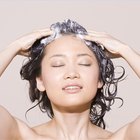
Image Source White/Image Source/Getty Images
Using lye hair relaxers is a popular treatment that straightens coarse or kinky hair. But before you head to the salon for your bi-monthly touch-up, consider what that lye is doing to your hair. Lye, also known as sodium hydroxide, is an especially potent chemical that can be deadly if ingested, warns Drugs.com. If it is so detrimental to your body, think of the damage it could be inflicting on your hair.
Burns and Irritation
When applied to the skin, lye can cause burns and irritation, says the U.S. Food and Drug Administration. If you decide to use a lye hair relaxer, go to a professional, and make sure that your hairstylist applies the lye away from your scalp. Burning of the scalp could result in redness, burning, itching and rash. No-lye hair relaxers exist, and can reduce the amount of scalp damage, but they may not work as well.
Dryness
Lye effectively strips your hair of amino acids and moisture, found a study by the Groote Schuur Hospital, University of Cape Town, published in the March 2010 issue of "Journal of the American Academy of Dermatology." This is especially detrimental for those who already suffer from dry hair, which kinky and course hair tend to be. The relaxing process usually takes at least 30 minutes, which means the chemical is sitting on your hair for that long. After washing out the relaxing solution, you may need deep conditioning, hot oil treatments, and hair masks to replenish moisture.
Damage and Breakage
Hair is essentially a dead protein, notes the American Hair Loss Association. Damaged hair lacks the active cells to repair itself. Unfortunately, lye hair relaxers strip the hair of moisture, and can burn or break the hair shaft. Once this damage occurs, cut off that hair. KidsHealth.org warns against using lye hair relaxers more often than every six weeks, and points out that heated styling tools can exacerbate the damage.
Related Articles

How to Get a Healthy Spiral Perm

How to Condition Hair After Using a ...

How to Control Frizzy Hair for ...

How to Get Rid of Built Up Soap & ...

How to Wash African-American Braids

How to Stop Your Hair From Looking Dry ...

What Does Lemon Juice Do to Your Hair?

How Long Does a Hair Texturizer Last?

Epsom Salts & Ingrown Hairs

How to Manage Thick, Coarse ...

How to Deep Condition Extensions

How to Moisturize Dry Hair Caused by ...

Dry Hair Treatment With Canola Oil

How to Get Rid of Calcium Buildup in ...

Products That Relax Curls

How to Shampoo Hair After a Perm

How to Perm Curl the Roots of Hair

How to Keep Temporary Dye From Fading

How to Cure Rough and Dry Afro Hair

How to Fix Dry Hair Ends
References
Writer Bio
Kay Ireland specializes in health, fitness and lifestyle topics. She is a support worker in the neonatal intensive care and antepartum units of her local hospital and recently became a certified group fitness instructor.
Photo Credits
Image Source White/Image Source/Getty Images